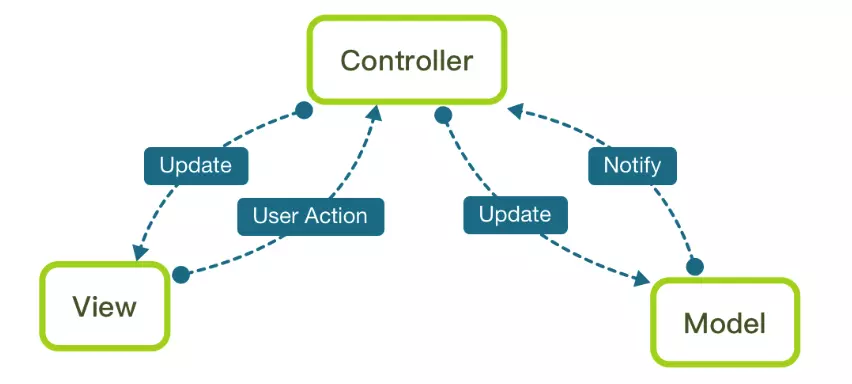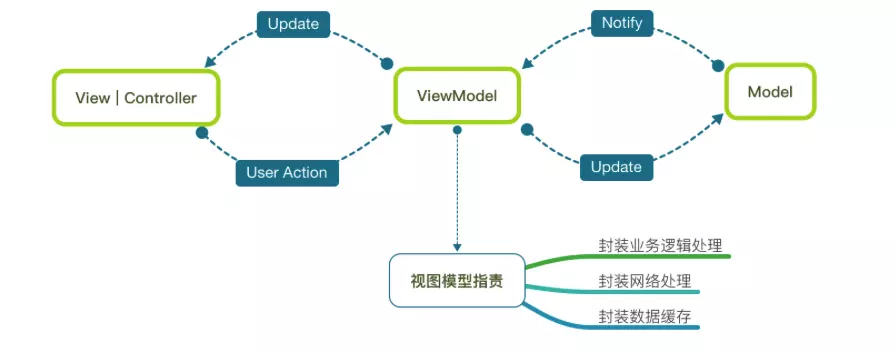为什么使用MVVM
iOS中,我们使用的大部分都是MVC架构。虽然MVC的层次明确,但是由于功能日益的增加、代码的维护,使得更多的代码被写在了Controller中,这样Controller就显得非常臃肿。
为了给Controller瘦身,后来又从MVC衍生出了一种新的架构模式MVVM架构。
MVVM分别指什么
MVVM就是在MVC的基础上分离出业务处理的逻辑到ViewModel层,即:
Model层:请求的原始数据
View层:视图展示,由ViewController来控制
ViewModel层:负责业务处理和数据转化
简单来说,就是API请求完数据,解析成Model,之后在ViewModel中转化成能够直接被视图层使用的数据,交付给前端(View层)。
MVVM与MVC的不同
首先我们简化一下MVC的架构模式图:


在这里,Controller需要做太多得事情,表示逻辑、业务逻辑,所以代码量非常的大。而MVVM:


MVVM的实现
比如我们有一个需求:一个页面,需要判断用户是否手动设置了用户名。如果设置了,正常显示用户名;如果没有设置,则显示“博客园0122”这种格式。(虽然这些本应是服务器端判断的)
我们看看MVC和MVVM两种架构都是怎么实现这个需求的
MVC:
Model类:
#import <Foundation/Foundation.h> @interface User : NSObject @property (nonatomic, copy) NSString *userName; @property (nonatomic, assign) NSInteger userId; - (instancetype)initWithUserName:(NSString *)userName userId:(NSInteger)userId; @end @implementation User - (instancetype)initWithUserName:(NSString *)userName userId:(NSInteger)userId { self = [super init]; if (!self) return nil; _userName = userName; _userId = userId; return self; } @end
ViewController类:
#import "HomeViewController.h" #import "User.h" @interface HomeViewController () @property (nonatomic, strong) UILabel *lb_userName; @property (nonatomic, strong) User *user; @end @implementation HomeViewController - (void)viewDidLoad { [super viewDidLoad]; //创建User实例并初始化 if (_user.userName.length > 0) { _lb_userName.text = _user.userName; } else { _lb_userName.text = [NSString stringWithFormat:@"博客园%ld", _user.userId]; } } @end
这里我们需要将表示逻辑也放在ViewController中。
MVVM:
Model类:
#import <Foundation/Foundation.h> @interface User : NSObject @property (nonatomic, copy) NSString *userName; @property (nonatomic, assign) NSInteger userId; @end
ViewModel类:
声明:
#import <Foundation/Foundation.h> #import "User.h" @interface UserViewModel : NSObject @property (nonatomic, strong) User *user; @property (nonatomic, copy) NSString *userName; - (instancetype)initWithUserName:(NSString *)userName userId:(NSInteger)userId; @end
实现:
#import "UserViewModel.h" @implementation UserViewModel - (instancetype)initWithUserName:(NSString *)userName userId:(NSInteger)userId { self = [super init]; if (!self) return nil; _user = [[User alloc] initWithUserName:userName userId:userId]; if (_user.userName.length > 0) { _userName = _user.userName; } else { _userName = [NSString stringWithFormat:@"博客园%ld", _user.userId]; } return self; } @end
Controller类:
#import "HomeViewController.h" #import "UserViewModel.h" @interface HomeViewController () @property (nonatomic, strong) UILabel *lb_userName; @property (nonatomic, strong) UserViewModel *userViewModel; @end @implementation HomeViewController - (void)viewDidLoad { [super viewDidLoad]; _userViewModel = [[UserViewModel alloc] initWithUserName:@"liu" userId:123456]; _lb_userName.text = _userViewModel.userName; } @end
可见,Controller中我们不需要再做多余的判断,那些表示逻辑我们已经移植到了ViewModel中,ViewController明显轻量了很多。说白了,就是把原来ViewController层的业务逻辑和页面逻辑等剥离出来放到ViewModel层。
总结:
- MVVM同MVC一样,目的都是分离Model与View,但是它更好的将表示逻辑分离出来,减轻了Controller的负担;
- ViewController中不要引入Model,引入了就难免会在Controller中对Model做处理;
- 对于很简单的界面使用MVVM会增加代码量,但如果界面中内容很多、Cell样式也很多的情况下使用MVVM可以很好地将VC中处理Cell相关的工作分离出来。
写到这里,MVVM基本上就算结束了。重要的还是去实践,在实践中检验真理。
https://www.jianshu.com/p/f1d0f7f01130